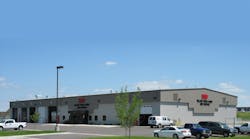Manager: Geoff Garafola
Title: Product & technical
information manager
Fleet: Inland Truck Parts Co., Kansas City, MO
Operation: A 28-store network of truck parts, remanufacturing services
and truck maintenance facilities
Problem: Managing 28 stores in 10 states isn’t easy, but it pales in comparison to providing parts and related maintenance services for trucks ranging from sport utility vehicles and pickups all the way up to their big medium- and heavy-duty brethren. But it’s what needs to be done to keep revenues and profits rolling in a highly competitive marketplace, says Geoff Garafola, product & technical information manager for Inland Truck Parts Co.
Established in 1944, Inland began as a truck parts-only chain of stores. In the 1990s, the company added truck maintenance services, buying out existing locations as well as building new facilities that eventually spanned Iowa, Kansas, Missouri, Montana, Nebraska, North Dakota, Oklahoma, South Dakota, Texas and Wyoming.
Yet getting all of these far-flung stores and shops to work in concert and also provide service tailored to the specific markets served by Inland’s facilities proved difficult.
“Some areas are more focused on light-duty business, others on heavy-duty,” Garafola explains. “We want each store to be independent, but we also want them to be mutually supporting. That can be a little tricky with the wide variety of customers we serve.”
Solution: Inland’s solution is two-fold, explains Garafola. First, use a common computer platform to not only track parts and service inventory in each store, but to allow that inventory to be viewed by all stores. And to ensure that all the stores “play fair” with one another, Inland relies on its employee-ownership structure so that success at one store translates into success for all.
“The key is to leverage our in-house advantages—in-house gear shops and on-site reman facilities that provide rebuilt and remanufactured transmissions, drivelines, clutches and more—with our truck parts and maintenance/repair options, all while providing more customized service,” Garafola points out.
“That’s why each store stocks its own parts specific to the needs of its market, while doing so on a common [computer] platform so all the stores can see what each other has on hand,” he notes. “That is where the employee ownership comes in; it goes hand-in-hand with our ability to quickly move those parts around and tap into our different in-house services.”
Garafola calls employee ownership the springboard for successfully integrating Inland’s disparate services and locations into a single team, even as its computer system links all of its offerings together in the digital sense. That team approach may be vital in order to benefit from growth in the $17.1 billion North American truck parts market buoyed by a continual rise in used-truck registrations.
Automotive market intelligence firm Polk, a division of global consulting firm IHS, reports that used-commercial vehicle registrations during the first half of this year totaled nearly 357,100, up more than 9% over the same period in 2012. Of significance is that the demand for this type of equipment continues to be strong and continues to outperform new registrations, Polk says. Used-commercial equipment transactions accounted for 56.7% of total commercial vehicle transactions during the first half of the year.
Inland is doing what it can internally to win—and retain—any parts and service business that might develop from the bigger population of used trucks operating in the U.S.
“I’m not saying it’s easy to cooperate like this; it’s not all blue sky and roses,” Inland’s Garafola says. “But [the message is] communicated constantly down from our executive team. We can’t grow our business and serve the many needs of customers acting completely independently. We need to cooperate and integrate to bring truck parts, reman offerings, and repair services together in a single package for customers to select from.”



